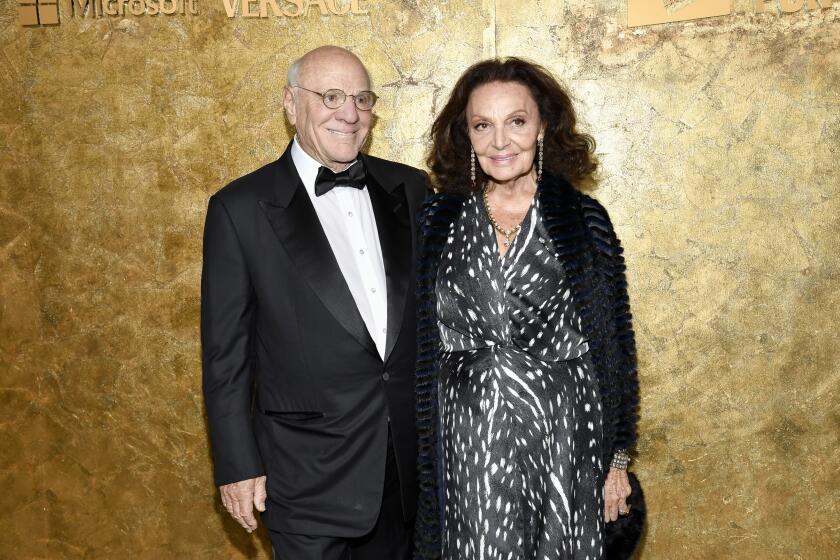COVER STORY : Those Were the Days : Remember when Hollywood was ‘the greatest fleshpot since Babylon’? Madonna’s <i> mom</i> wasn’t born yet!
- Share via
Since the beginning of movies, many people have considered them a corrupting influence. In 1897 some theater owners put white strips across the screen when unspooling “Fatima’s Dance” to conceal fully clothed but wiggling breasts and hips.
A series of scandals in the early 1920s--the marriage of Mary Pickford to Douglas Fairbanks only one month after her divorce, the murder of William Desmond Taylor, the rape and murder trial of Fatty Arbuckle--convinced much of the public that Hollywood, as Fortune magazine later put it, “had become the greatest fleshpot since Babylon.” Millions of Americans banded together in women’s clubs, church organizations, patriotic societies and youth movements to express their outrage over the increasing salaciousness of the movies. Legislators in 37 states introduced censorship bills.
Echoing these sentiments, publisher William Randolph Hearst, in a signed 1927 Los Angeles Examiner editorial headlined “Purer Films Vital to Industry and Public Morals,” wrote: “Thank Heaven, the larger element of the American public are wholesome, pure-minded people, who do not approve of suggestive films. . . .”
Ultimately, fears of externally imposed censorship led Hollywood to impose its own controls through the Production Code, which dominated the film industry for more than three decades until it was replaced in 1968 by the ratings system. Without a seal of approval from the Production Code office, movies could not play in major chains. At the same time, several states and a number of cities had censorship laws of their own.
Censorship was legally possible because the U.S. Supreme Court held in 1915 (in a ruling not reversed until 1952) that movies were not protected by the First Amendment.
The 1930 Production Code, drafted by a Catholic lay leader and a priest, declared that “the sanctity of the institution of marriage and the home shall be upheld. Pictures shall not infer that low forms of sex relationship are the accepted or common thing.” David O. Selznick’s Anna Karenina, for example, was not allowed to have an illegitimate child.
Curiously, the code made no mention of abortion. Nevertheless, in the early days, when abortion did appear in a script, as in “Rebecca” and “Kitty Foyle,” it was deleted without protest, according to “The Dame in the Kimono,” a book about the code by Leonard J. Leff and Jerold L. Simmons. By 1949, however, the studios were putting up a fuss. While no direct mention of an abortion occurs in “The Doctor and the Girl,” there are hints--as a result of a compromise between MGM and Joseph Breen, the man who served as director of the code for two decades--that an illegal operation has taken place.
The Production Code was not limited to sex. Murder had to be “presented in a way that will not inspire imitation.” No extensive safe-cracking scenes were allowed; dead bodies could not be shown. Illegal drug traffic and drunkenness were also banned. The inmates in the 1938 B picture “Condemned Women” could not cry “Fire!” while pounding on their prison bars, lest the word cause panic in the theaters.
Many other words were also prohibited, although Breen eventually allowed Rhett Butler to utter the word “damn” in “Gone With the Wind.” But since “scenes of actual childbirth . . . are never to be presented,” Melanie Wilkes’ baby had to be born off screen.
By the late 1940s, of course, the blacklist period began to unfold, and criticism of sex and profanity in Hollywood temporarily yielded to issues of subversiveness. But drawing a connection between the two issues, Louis B. Mayer urged the industry in 1949 to revert “back to its original objective of supplying clean, wholesome pictures for the family trade.”
Although Hollywood has always been a target of local politicians and religious leaders, it is only in recent years that Presidents and vice presidents have entered the debate. Vice President Spiro Agnew inveighed against the “nattering nabobs of negativism,” among whom he included broadcasters.
After seeing “Love Story” in 1970, President Richard M. Nixon said he was shocked by “the dialogue they put in the girl’s mouth.” Profanity, said the President whose White House tapes are studded with expletives, “has its place, but if it is used it should be used to punctuate.”
But it was President Ronald Reagan who gave voice to a critique that was to become a key element of the Republican agenda. “Reagan and his acolytes personified a cultural fundamentalism that reassured conservatives, particularly religious conservatives, that the Republicans shared their dismay over the shifts in the nation’s mores reflected by . . . changing artistic styles,” wrote Times national political correspondent Ronald Brownstein in his book “The Power and the Glitter: The Hollywood-Washington Connection.”
In 1982, Reagan reminisced about the time when feature films and television shows left more to the imagination, telling a television trade association about a bedroom scene in “The Winning Team” in which he played baseball player Grover Cleveland Alexander and Doris Day played his wife.
“They (film audiences) saw me. I very quietly got out of bed, and then you saw Doris lying there asleep on the other side of the bed,” Reagan recalled. “But you never saw the two of us in bed together.”
“I’d like to see those days back, and I think all of you would be better off . . .,” he added.
After leaving office, Reagan took this theme to Japan, where he said he supported the Sony Corp.’s acquisition of Columbia Pictures. “I’m not too proud of Hollywood these days with the immorality that is shown in pictures and the vulgarity,” he said in a 1989 television interview broadcast in Japan. “I just have a feeling that maybe Hollywood needs some outsiders to bring back decency and good taste to some of the pictures that are being made.”
Reagan later apologized to the entertainment industry for these remarks.
More to Read
Only good movies
Get the Indie Focus newsletter, Mark Olsen's weekly guide to the world of cinema.
You may occasionally receive promotional content from the Los Angeles Times.










